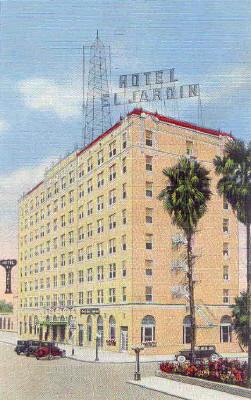|
Not
quite 20 miles up the Rio Grande from the Gulf of Mexico, Brownsville
had an airport before it got a sea port.
With much fanfare spread over a two-day celebration, the Brownsville
Airport opened on March 8, 1929. In addition to all the local and
state politicians, businessmen and other dignitaries attending the
event, Charles “Lucky” Lindbergh, who less than two years earlier
had flown non-stop from New York to Paris landed at the new Valley
airport with the first load of airmail from Mexico City to New York
City. |
Pan-American
Airways Terminal in Brownsville
Postcard courtesy rootsweb.com/%7Etxpstcrd/ |
With an escort
of Mexican military pursuit planes, Lindbergh arrived at 1:53 p.m.
on Sunday, March 9. An estimated 20,000 people turned out to greet
the famed aviator. He departed at 10 a.m. the following day on a return
flight to Mexico with a load of mail that had been flown to Brownsville
from New York.
Not only did Lindbergh’s arrival and departure from the new airport
mark the beginning of international air mail service in the U.S.,
stamp collectors acknowledge it as the first time an air carrier managed
to lose luggage – in this case numerous bags of mail. Even though
recovered a month later, the cancelled envelops are now known among
philatelic folks as having come from the “Lost Mail Flight.”
Scores
of airplanes from both sides of the Rio Grande flew to Brownsville
’s new air field as part of the festivities. The Army Air Corps dispatched
more than 100 aircraft, a large percentage of the entire corps. Using
the new airport, American military aviators performed aerial maneuvers
with their counterparts from Mexico.
Shorty Radeck, a wing walker, amused spectators by strolling along
the top wing of a bi-plane flown by his partner in stunt flying. Radeck
also parachuted from the plane. But his signature stunt was jumping
from the plane as it roared by the crowd only a few feet above ground.
He landed on his feet and then ran to a stop. |
 |
Hotel El Jardin
Postcard courtesy texasoldphotos.com |
| While VIPs enjoyed
a banquet at the El Jardin Hotel (feasting on fresh fish flown in
from Soto de la Marina, Mexico), the public got to see a rare night
landing of a Ford tri-motor plane operated by Universal Air Lines.
Flares attached to parachutes provided enough light for the pilot
to get the plane down. |
A Ford Tri-Motor
on display at the Naval Aviation Museum in Pensacola, Florida
Photo courtesy Sam Lester |
Another
notable figure on hand for the Brownsville
festivities was a female flyer originally from Kansas, Amelia Earhart.
She had served as navigator on a cross-Atlantic flight the year before,
becoming the first woman to fly between the U.S. and Europe, even
though she did not pilot the aircraft. Now she had begun to fly planes
herself.
Les Mauldin, the manager of the new Valley airport, loaned Earhart
a plane so she could take her flight test for a commercial pilot’s
license. She passed the exam. Eight years later she flew into aviation
history immortality, vanishing on a flight across the Pacific.
Opening
an airport in the Rio Grande Valley with proceeds from bond sales
proved to be an excellent civic investment. (The Port of Brownsville,
located at the end of a 17-mile channel from the mouth of the Rio
Grande, was not opened until 1936.)
In June 1929, Pan-American Airlines leased the airport for use in
its growing South American service. Three years later, the airline
established its Western Division headquarters at the Brownsville airport.
In addition, the airline constructed a large repair and maintenance
facility there.
Pan-Am’s advertising campaign featured a large magazine and newspaper
ad showing the carrier’s far-flung routes. The map showed that all
the airline’s Latin American flights had stops at Brownsville.
As the ad pointed out, though Brownsville
lay 2,301 miles from the Panama Canal, by air that distance could
be covered in only 14 hours.
Just to underscore how much more efficient air travel had become,
the ad noted that the average speed of a passenger train was 40 miles
an hour. Average automobile speed was 50 mph. From there, the speed
increased to 120 miles an hour for a Pan-Am Ford tri-motor plane and
200 miles an hour for a Douglas-built plane.
Brownsville
continued to play a major role in Pan-Am’s operations until the mid-1950s
when the development turboprop and then jet planes made piston-powered
aircraft obsolete. Pan-Am closed its Valley facilities at the end
of the decade and moved its Western Division headquarters to Miami.
The pioneering airline went into bankruptcy in early 1991, its assets
absorbed by Delta Airlines.
With international airports at McAllen
and Harlingen
in addition to Brownsville,
aviation continues to play an important role in the Valley’s economy.
But wing-walking is a long-lost art. |
|
|
